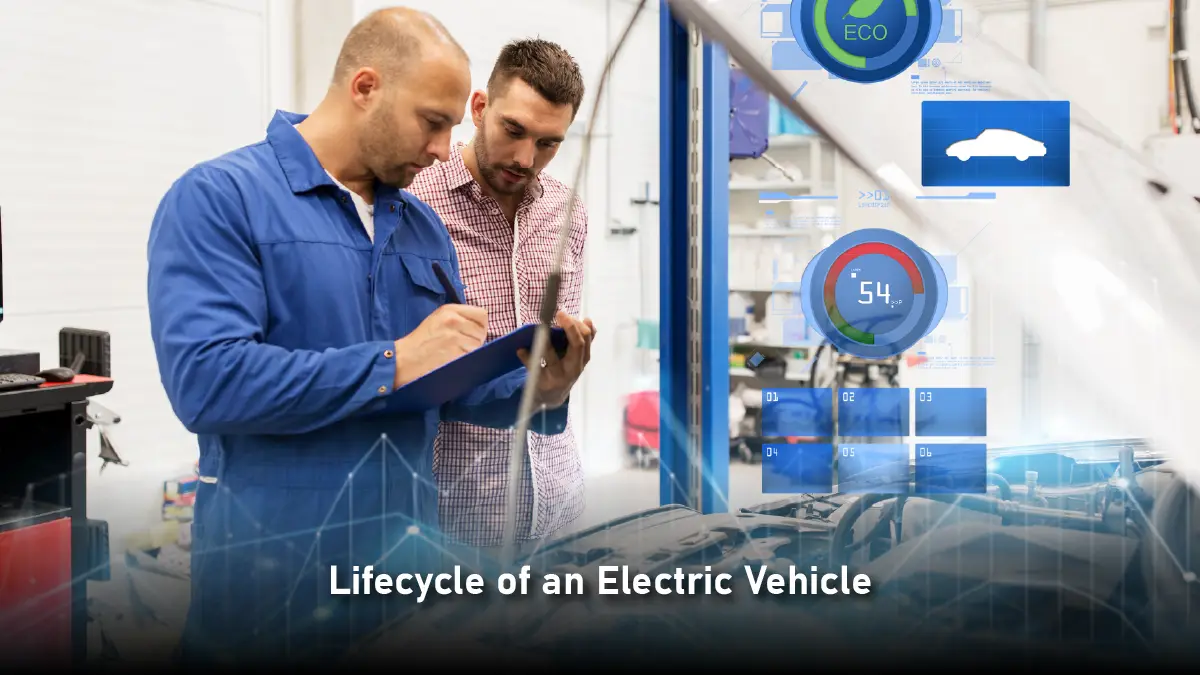Electric vehicles (EVs) are cars that run on electricity instead of gasoline. Many believe that EVs are more environmentally friendly. But to know if this is true, we need to look at every step in an EV’s life. This article will explain each step; Where do the materials come from, how is the car made and used, and what happens when it is old or broken? We will also compare EVs to regular cars, talk about the challenges, and look at the future of EVs.
Lifecycle of an Electric Vehicle

1. Mining
The first step in making an EV is getting the right materials. Lithium, cobalt, nickel, and rare earths are used to make EVs. These are used to make the battery and the electric motor. Most rare earths come from China. Argentina, Chile, and Australia supply lithium. The Democratic Republic of the Congo is the primary source of cobalt.
A lot of energy and water is used in mining activities. Chemicals are occasionally employed to extract the metals. This can pollute rivers and lakes. Mining can also lead to encroachment of jungles, hurting animals and plants. People who live near mines face several problems. Sometimes, their land is damaged or they have to move away.
Scientists and companies are trying to find better ways to mine. Some are using less water and fewer chemicals. Others are trying to get these metals from old electronics instead of digging new mines.
Also Read: Contested Logistics: Navigating Supply Chains in Geopolitically Unstable Regions
2. Manufacturing
The second step is to make the car and the battery. The manufacturing process of an EV similar to that of a regular vehicle. Workers put together the body, wheels, seats, and other parts. But, EVs also need a big battery and an electric motor.
Making the battery uses a lot of energy and can create pollution. This is because the raw materials must be turned into battery parts. Because of the battery, making an EV can be worse for the environment at first than making a gasoline car. But over time, EVs become cleaner.
The rest of the car is like a regular car. The main difference is the battery and the electric motor. As technology gets better, making EVs will become cleaner.
3. Using the Electric Car
EVs run on electricity stored in the battery. They do not have a tailpipe. So, they do not send out polluted air like gasoline cars. This is good for the environment.
However, the electricity utilized to charge the vehicle is important. There is still some pollution even if the power is generated by gas or coal. Clean energy sources like solar or wind power have positive effects on the environment.
EV charging is simple. Most people charge their cars at home overnight. There are also public charging stations. Some people use solar panels to charge their cars, which makes them cleaner.
4. What Happens When the Car Gets Old?
After years of utilization, the battery in the EV will not work as well. Most EV batteries last 8 to 15 years. Old EV batteries can still be used for other things. They can store electricity for homes or businesses. This is called ‘second life.’
Old EV batteries can be recycled. The battery can be taken apart and metals like lithium and cobalt can be retrieved. These metals can be used to make new batteries. This indirectly helps the environment. This is because the same metals are reused, reducing the dependence on mining.
Recycling EV batteries is still new. It is not always easy or cheap, but it is getting better. Some companies are building special factories just to recycle EV batteries.
Comparing Electric Vehicles and Regular Cars

EVs are cleaner than gasoline cars. Even though making the battery creates some pollution, driving the car is much cleaner, especially if the electricity is clean.
EVs are also better for people’s health because they do not make dirty air. This means fewer people get sick from air pollution. Recycling the battery helps even more.
Here is a simple table to compare EVs and regular cars:
| Step | Electric Vehicle (EV) | Regular Car |
| Mining | Needs rare earths, lithium, etc. | Needs oil, less rare metals |
| Making | More pollution from battery | Less pollution |
| Driving | Cleaner, no tailpipe, depends on electricity | Non-environmental friendly, lots of pollution |
| End of life | Battery can be reused or recycled | Engine can be recycled |
| Overall | Much cleaner over time | More pollution over time |
Common FAQs About Electric Vehicles
- How long do EV batteries last? 8-15 years
- Can old EV batteries be used for anything else? Yes, old EV batteries can store electricity for homes or businesses. This is called ‘second life’.
- Is it easy to recycle EV batteries? Recycling EV batteries is new, but getting easier and cleaner.
- Are EVs really better for the environment? Yes, EVs are much cleaner than gasoline cars, especially if the electricity is clean.
- What are the main problems with EVs? Mining, not enough charging stations, recycling old batteries.
Challenges
EVs are good for the planet; but they have some issues.
Mining can harm the environment and local communities. In many areas there are not enough charging stations. This makes it hard for drivers to charge their cars. Recycling EV batteries is a new process and not always easy. But it’s getting better as technology improves.
Switching to EVs is a good step. But there’s still work to be done to make them as clean and convenient as possible.
Future of Electric Vehicles
The future of EVs looks good. Batteries are getting better. They will last longer and use less material. Driving an EV will be even cleaner as more electricity is generated from wind & solar. The IEA says solar PV accounted for about 70% of renewable energy growth in 2023. The rest of the growth came from wind generation.
There are still issues with mining. Nonetheless, companies and researchers are working to make it safer and less hazardous. More charging stations are being built by governments, and incentives are being provided for EV purchases. Laws limiting driving to electric vehicles are being enforced in some regions.
Conclusion
Using electric vehicles is a significant step toward cleaner transportation. They contribute to energy conservation, pollution reduction, and health protection. We can all live in a better world if we embrace clean energy and electric vehicles.
Remember:
EVs need special materials from mining.
Making the battery creates some pollution.
Driving an EV is cleaner than a gasoline car.
Old batteries can be reused or recycled.
EVs are good for human health and the environment.
Electric vehicles contribute to a cleaner and better transportation future. Everyone will live in a cleaner and better environment as technology advances and more people choose electric vehicles.




